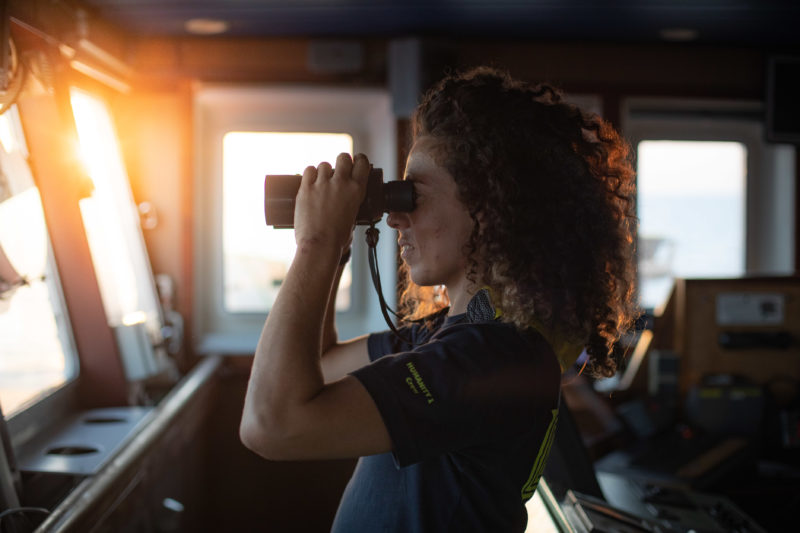Blog from aboard 04

A maritime emergency is reported, and we increase to maximum speed. A search that lasts for hours begins. Press officer Petra reports directly from the operation of Humanity 1.
Wednesday, 19 October 2022, Mediterranean
On Monday evening, we receive a message from Alarm Phone about a possible distress case. A relative contacted the NGO, an emergency hotline for refugees, about a rubber dinghy with 104 people that is reported to have left the Libyan coastal region of Alaluas, between Tripoli and Al-Khums, at around 5 a.m. At 6 p.m., the relative had the last mobile phone contact with the people on the boat which at that time was said to be 30 nautical miles, or about 60 km, away from the coast. Since then, no signs. Around 9 p.m., we receive the email from Alarm Phone with the few details they have available. We immediately head east-southeast, doing over 10.5 knots, about our maximum speed.
I leave my cabin at 9:30 p.m. to find out why we are suddenly going so fast. Before, we were only running at half speed. I meet Samir, our bosun from France. He tells me about the message and the search for the distress case. “Around 2 a.m., we will reach the approximate position of the dinghy,” he reports. I assess whether it is still worth going to sleep, because the adrenaline kicks in immediately. With the prospect of having the first rescue in the middle of the night, I will hardly be able to sleep. I make my way to the bridge to find out more. I find Camilla, our Communications Coordinator, on the way. “We have no indication of the boat’s current position. Unless we get an update, the chance of us finding the boat before dawn is very small. So you can go to sleep without worrying too much”, she says.
To estimate the approximate position of the boat, we would need to know the time and exact place of departure. In this case, it’s the location in particular that remains vague. Alaluas is a large area, not a precise place. Our bridge team, taking into account wind, current and swell, has determined the likely place where the boat might be the time we can be in the area. After arriving there about 4 a.m., we have been running a search pattern called “parallel pattern”. Since the night we have had a double lookout on the bridge, which means two crew members are using binoculars to search the horizon for the “target” we are looking for.
“We kept seeing little lights on the horizon, red, blue and white”, Till, who is actually the head of ship operations for SOS Humanity, but on board for this mission as RHIB coordinator, tells me. “The white ones could be torches on the dinghy”. Till spent the night on the bridge supporting the search. The lights turned out to be fishing boats.
From sunrise, the lookout will be moved to the top deck, the highest and smallest deck on board. Every 1.5 hours, the two lookout duty officers are replaced. The concentrated scanning of the horizon line with binoculars is tiring and very exhausting for the eyes. At some point, the water surface and the sky start blurring, mixing with the sea. Even small waves repeatedly obscure the view of a possible boat behind.
At around 10:30 a.m. the captain spots a larger boat on the radar, we can see it quite well through the binoculars. As it was travelling very fast at first and then only at one knot, we reckon that it is the so-called Libyan coast guard and that we must be witnessing a pull-back. We approach slowly, because if our assumption is correct, we at least want to photograph the empty boat. The pull-back of people fleeing Libya to the country from which they fled is illegal. But then it turns out that it is a large fishing boat. After the continued search yields nothing and no news on the case comes in, we suspect that the boat was intercepted by the so-called Libyan coast guard.
In the morning, there is information about a second boat in distress, which Alarm Phone reports by email. The engine is said to be broken, the number of people in it is unknown. We now also search for this boat. Around noon, Alarm Phone reports that the dinghy has landed in Libya again. The waves must have driven it back.

The mood on board is pensive in view of the unsuccessful search for the first distress case, the boat with more than 100 people. Over the comparatively quiet lunch, I talk to our Search and Rescue Coordinator (SARCo) Dragos about the case reported last night. “Apart from the inaccuracy of the place and time of departure we don’t know how powerful the engine is, whether it is working continuously and which direction the boat is exactly steered in; and if we don’t get an update on the position of the distress case, then it is difficult to find the boat.”
We have resumed our normal search patrol at around five knots. I am thinking about the people on the boat and wonder where they are now and how they are doing.



